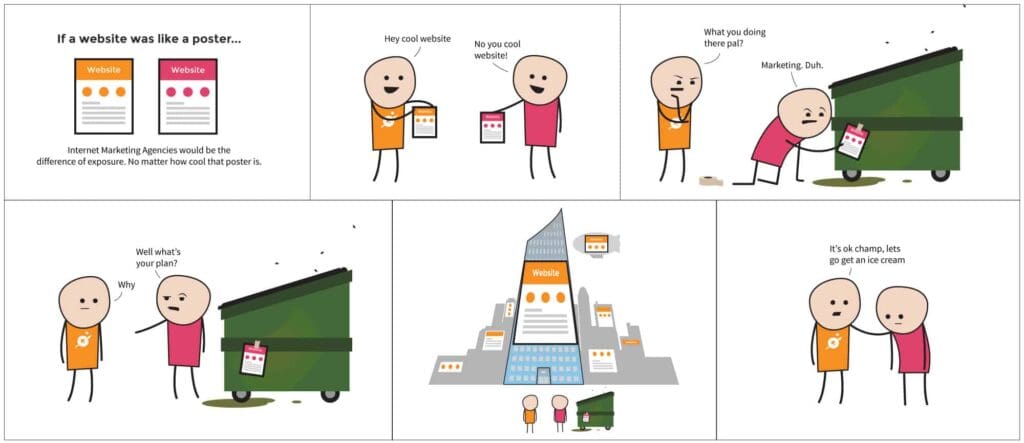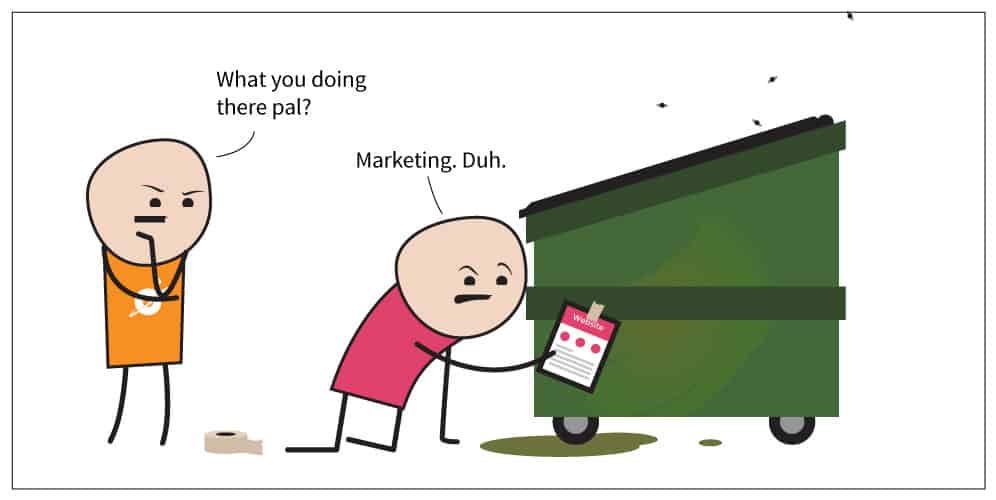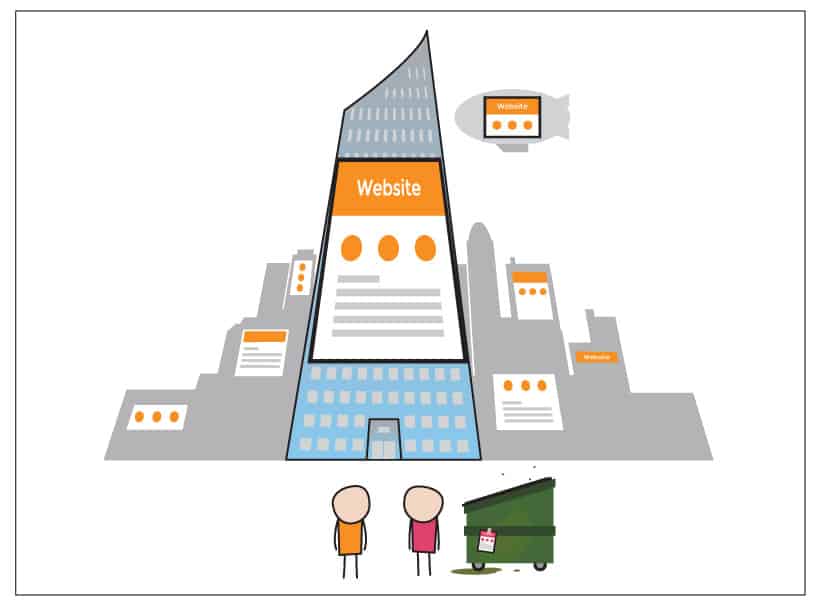
Imagine you’re in a library doing research for a college paper. All of the books are thrown into a pile on the floor. You basically have to swim through the books to find what you’re looking for. The best book ever might be buried in that pile. But, what are your chances of finding it? The same goes for content. Content visibility can be met through internet marketing efforts. You can write really great content, but without a solid strategy to back it up, it’s going to prove tough to compete with the big competitors. With more than 92,000 articles posted on the internet every day, the competition is tough. WordPress users alone produce over 35.8 million new posts a month. Digital media publishers, like Huffington Post, are known to publish anywhere up to 1,500 articles a day. How does your small business stand a chance? You must develop a content strategy that positions your business as an expert and gets you noticed online. Here’s how you can increase your content visibility and get it noticed:
Implementing a great content strategy increases the chances of your article or blog getting found online. Don’t let your business get buried under a pile of books. Get organized, get your key-words, in order and get in the card-catalogue of the internet.

The weather is perfect. The DJ has mixed a super cool play list. The food is exquisite and the drinks are cold. This will be the best party ever…if the guests ever arrive! Cue the screeching tire sound effects. OMG! You forgot to send out the invites. Spending time, energy and money on a great website without internet marketing is just like throwing a fabulous party and not inviting anyone. What’s the point? Throw that online party! Plan it, send out invites and be the talk of the town.
1) Guest List: Target your market. Who are the people you want to come to your site… the ones that have a need or interest in your services? Identify and invite! 2) Invitations: How are you going to get your target market to attend? Do key word research and present relevant content that attracts them to your site. In web lingo, this translates to SEO, blogging and social media efforts that increase your organic search rankings. 3) Entertainment: You got them there, now what? Make sure your decorations are awesome and the guests are having fun. In other words, make sure your site has a simple, clean design; is easy to navigate, has spectacular photography, custom iconography and info graphics. The better the experience, the longer they’ll stay. The more engaged they are, the better chance you have to convert them to a client. 4) Don’t leave yet! Check your key performance indicators: traffic volume, reach, profit goals, ROI targets and demographic spread. Evaluate and make adjustments accordingly to keep clients on the site longer and coming back for more! Having the proper tools for accurate reporting is most helpful. 5) Party Favors: They like your party, so send them home with something meaningful. A downloadable pdf with great industry tips…A free consultation…A sample of your most popular product. 6) Update your address book: Or your CRM. You’ve met all these new friends, so stay in touch. Get an email address so you can send interesting facts, industry updates, links to blogs, weather and travel tips. Invest in the lifetime value of a client and you’ll keep them forever.

Creativity reigns supreme right? It is common knowledge that only the coolest websites get top exposure. Part of me, as a web designer, hopes this would be true. However, creative web design only takes a business so far. Ultimately, there are thousands of terribly designed websites that get more traffic than award-winners. If you want your website to work for you beyond a cocktail party talking point, then you need to know that Web Design is a part of Internet Marketing and not the same thing.

As cleverly explained by the cartoon, you can have the most creative and interesting website in the world, but if you market it horribly, then not many people will see it and you won’t get a very good return on your investment. OCG Creative’s team of dedicated and nerdy Reno web designers and developers work hard to produce these award winning sites. We have done this for numerous clients for many years. Part of the creative web design also involves the user’s experience with the website, which is why an analogy of a website being a poster is only part-true. In reality, a website is a fluid document – it changes with input from the user and looks different on different devices. OCG works to build the coolest website imaginable for our clients, but we know at the end of the day that it is essential to market it correctly, and websites should never stop when the design is completed.

As a secret confession, I used to wonder this question all the time. There are plenty of online tools to build a website, and before I became a web designer, I even built my own portfolio using one of these tools. The issue with all of them… they’re awful. Even discounting the fact that all of them stop at the end of web design, the web design itself is clunky, confusing, and very limiting. I didn’t realize this until I experienced it first hand. A website should never stop at the end of creative web design. Instead, it should be a rocket-powered branding piece pushing the client forward to more exposure and spurring the start of a comprehensive effort to convert website visits into leads. OCG custom designs each website so it is beautiful and branded, but most importantly, they are scalable and sturdy for expansion in traffic and tailored to convert site visitors into customers.
After website design is completed, many people stop and never touch it again. It’s similar to making a cool poster and then never posting it anywhere. Why? Internet marketing takes effort, DIY site builders don’t have the resources to market each site created and the sites themselves are cluttered and reject efforts to market them. A lot of this is due to lack of on-site SEO support in addition to other elements such as effective landing pages and lack of Conversion Rate Optimization. It is much easier to stop after finishing the web design part.
The point is, OCG Creative is a dedicated and experienced Reno web design and internet marketing agency that has the resources. Websites should be built to be optimized for internet marketing. The issue with DIY site builders, is the website's inability to integrate with a meaningful and comprehensive marketing campaign for individual clients. This is because DIY sites purposefully exclude any means of integrating with an internet marketing plan, it is simply too much effort for DIY site builders to accommodate these features. Internet marketing takes time and a sturdy website foundation specifically built for internet marketing. Additionally DIY site builders don't want to manage campaigns because they take time and constant tuning. Hard work with SEO, Landing Pages, CRO, and other services, take time to gain traction. OCG maintains these campaigns, constantly tailoring our client’s Internet Marketing plans to coincide with optimal conversions including tracking page visits and valued keywords to get them ranking higher. You can’t get that level of detailed attention with do-it-yourself websites. It takes significant time, specialized data collection, and informed decisions to be implemented after data collection to market a website correctly.
If you’re not sure where to go from here knowing all of this or if you still think an awesome looking website is the most important thing for you or your business, give us a call or browse our other topics. We’ve been doing this for a while and know the internet marketing world front and back.


With over 15 years of print experience, Charles Driver, Print Manager of OCG Creative, weighs in on the importance of having quality print marketing materials that represent your brand in a professional light. I have to admit that I’m a bit of a printing snob. Whenever I visit a local place in Reno, the first thing I do is take a look at the print marketing pieces they have lying around. Whether it’s business cards, brochures, or menus—a few things instantly pop into my mind. I can usually tell a company’s marketing budget and how much importance they put on their branding just by looking at their print collateral.
First off, does the piece look like it was created in a bootlegged copy of some office writing program? It’s very easy to tell when a talented designer had a hand in a particular design. You may not even realize it, but behind the scenes, your brain is making assumptions about the design. Subconscious lines are being drawn and everything is measured against a Fibonacci sequence. Go ahead, give yourself credit, you know good design when you see it. It’s colorful, vibrant and draws your eye in just the right path across the surface of the material. A poor design, on the other hand, consists of a basic border around the page, a begrudging splash of color, and generic fonts—looking at you Times New Roman. Poor aesthetic sends a clear message: we spent no time designing this piece. How is this going to represent your business? At the end of the day, it pays to invest in a good graphic designer.
Let’s be honest, glossy paper has been out of fashion for a long time. Just like a car immediately depreciates in value when you drive it off the lot, so does any marketing piece printed on gloss. It loses its luster as soon you pick it up from the printer. Fingerprints and high glare are unattractive in the hands of your target audience. Choosing a matte dull paper type is classy, looks good in all lighting conditions, and leaves room for accents. Want to add a kick? Go heavy, everyone has basic printer paper laying around somewhere but there are other tiers to consider between basic and card stock. Handing out flyers? Try something in a 28lb. Giving out menus? 80lb book makes the presentation a tactile feast and prevents images from bleeding through on the other side.
A trend that is not entirely new, but certainly gaining more traction is using a spot UV coating to highlight certain elements of a printed piece. Spot UV simply means selective gloss coating, and a good designer will offer plenty of unique ways to use it. After discovering this option in printing a few years ago, I’m now seeing this subtle, yet enticing accent in everything I purchase, from merchandise boxes to book covers. While I do see Spot UV enjoying its time in the sun for many more years to come, if you want to get ahead of the curve try a satin or silk coating. If paper type can be considered a tactile feast, then you’ve just been invited to a fancy dinner with steak and lobster when you use satin or silk. While they’re still considered a matte finish, these two coatings have a striking visual quality that is matched only by how they feel in your hands. These pieces demand to be taken home. In the end, design is the first and possibly the most important step in your printing journey. What your piece says about you right now decides whether it gets tossed in the bin or hung on the fridge. Designing your piece for print should be a collaborative and engaging process. The design itself should speak to the overall purpose of that piece. If I’m wandering through your establishment, I’m certainly looking and making judgements about your brand.
Learn more about the printing services that OCG Creative can offer,
 If you want to start an email campaign for your business, you might be tempted to buy a list of leads. Before you do that, I would suggest something even better, and that's building an organic list from your website. Why? Building your email list organically ensures that your leads will actually want to hear from you. It will result in less opt-outs and getting marked as spam. If you get marked as spam too many times, you run the risk of being "blacklisted" or blocked from email servers. If you're new to this, do not fear. You can build your own list through website lead generation.
If you want to start an email campaign for your business, you might be tempted to buy a list of leads. Before you do that, I would suggest something even better, and that's building an organic list from your website. Why? Building your email list organically ensures that your leads will actually want to hear from you. It will result in less opt-outs and getting marked as spam. If you get marked as spam too many times, you run the risk of being "blacklisted" or blocked from email servers. If you're new to this, do not fear. You can build your own list through website lead generation.
Lead generation online consists of building a list of qualified individuals who are interested in your products or services. You can collect this information through forms and calls to action (CTA) on your website. How do you get visitors to fill out forms? Offer something of value. People will exchange their contact information for something that benefits them or sparks their interest. At minimum, you want to collect a name and email address. However, for more extensive offers, you can ask for a mailing address and phone number. Make sure you don't ask for too much information upfront, as it will cause people to bounce off the page. Are you ready to start building your email list? Here are a few different campaigns you can use to start generating leads on your website:
Is your business taking advantage of offering discounts online? Now, this may seem like a no-brainer, but sometimes the best way to get somebody to initiate contact is through an old-fashioned freebie. Giving an attractive discount, free sample, or trial offer can attract leads that otherwise would have kept on clicking. How to do it: Incorporate a free offer or discount into a landing page, pay-per-click ad, or social media ad. Make sure you pick one goal for the user and focus your landing page around that. Learn more about landing pages here.
To blog or not to blog, that is the question. When you blog for your businesses, you create the opportunity to attract new leads by positioning yourself as a thought leader in your industry. You can also position yourself as an expert by creating educational videos, downloadable guides, white-papers and E-books. Offering exclusive content is a great way to build your list and generate leads. How to do it: Integrate a sign up form with your content offer at the end of a blog post or on a landing page. Blog posts are great because your audience is already reading your material and might want more information. Having trouble coming up with content? Read our tips on overcoming writer's block.
You know you love the camera. If not, that’s okay. You can still host an online class or webinar via podcast or voiceover. Do it live or send out recorded sessions—the choice is yours. There’s endless options for connecting with potential leads all over the world now, and turning your office into a virtual classroom. How to do it: Develop your content and promote your class via a landing page that can be shared through ads, social media or on your website. People will exchange their contact info in exchange for the free class. If it’s good enough, it may convert them to a customer! Alright, I have to go do some online shopping. And my coffee is cold. Cue the end of this blog post. Thanks for reading and check back for more marketing tips and lead generation ideas!
 You did it! You finally opened that business you’ve been talking about for years. Now what? It’s the perfect time to make a great first impression. Often times businesses overlook the importance of the little things--business cards, flyers, brochures, posters, signs and the impact print marketing materials can have on the business. Think of what a great impression you make in person when sharing your excitement about your business. Now think about what your business looks like when you’re not there to represent it. Do your business cards leave a lasting impression like your meetings do? Does the post card you send out or the flyer you hand out look as professional and hip as your company really is? Taking time to create print collateral that represents your company image is as important as paying the electric bill. If your potential clients aren’t attracted to your print marketing pieces, then you’ve missed the mark.
You did it! You finally opened that business you’ve been talking about for years. Now what? It’s the perfect time to make a great first impression. Often times businesses overlook the importance of the little things--business cards, flyers, brochures, posters, signs and the impact print marketing materials can have on the business. Think of what a great impression you make in person when sharing your excitement about your business. Now think about what your business looks like when you’re not there to represent it. Do your business cards leave a lasting impression like your meetings do? Does the post card you send out or the flyer you hand out look as professional and hip as your company really is? Taking time to create print collateral that represents your company image is as important as paying the electric bill. If your potential clients aren’t attracted to your print marketing pieces, then you’ve missed the mark.
Print them in bulk and hand them out like candy. If you’re making excuses for your business cards, it’s time to rethink your approach. Add spot UV to a silk finish for a great looking, great feeling card.
Pick an uncommon size. If it looks like all the rest, it will get lumped with all the rest. Stand out! Try a square brochure or one with rounded corners.
Print on both sides and make sure to use lots of stunning photos and color. Black letters on neon yellow paper should be used for yard sales and school projects.
Having a retractable banner is handy to set up at trade shows, networking events and impromptu sponsorship opportunities. Create a visually spectacular banner with company info and be ready to dazzle any crowd. Hanging banners can be powerful as well and come in a variety of sizes: from small table banners to building banners that are temporary signs. Regardless of the size, make sure the presentation and message are well thought out.
Mail boxes get bombarded with junk mail. Make sure your mailer looks a cut above the rest and doesn’t get hidden behind all of the #10 envelopes. Find a size that stands out in the clutter and focus on eye-catching graphics and simple, powerful messaging.
The best signs are the ones that can be seen and read from long distances. Don’t clutter a sign with unnecessary info or graphics. Choose colors and lettering that that are easy to read any time of day. Your print collateral serves as your marketing, your lead generation tool, and represents your company brand. It also paves the way for your future efforts: website, social media, email marketing and internet marketing. So, take the time and effort to make sure that all of your collateral represents your business in the way you would in person. Are you a new business? OCG Creative can print all of your business collateral with a fast turn around. If it has a surface, we can brand it! We have curated many print marketing materials for a multitude of clients both locally and nationally. Contact us to learn more.
 First off, if you’ve taken the dive to start blogging for your business,—congratulations! That’s a big step in creating content for your audience, while also improving SEO efforts for your website. However, the thing that most blogger’s struggle with is actually completing their writing assignments so keep on reading to gain knowledge on blogging tips and tricks. Here’s a funny story. A few months ago, I broke my finger in a garage door. Even though I was wearing a brace, I still kept writing blogs and meeting with clients. For 8 weeks, I managed to meet all of my writing deadlines WITH a broken finger. I tell this story because if I can do it, then you can too. Let’s just say, if anything, it was a good conversation starter….
First off, if you’ve taken the dive to start blogging for your business,—congratulations! That’s a big step in creating content for your audience, while also improving SEO efforts for your website. However, the thing that most blogger’s struggle with is actually completing their writing assignments so keep on reading to gain knowledge on blogging tips and tricks. Here’s a funny story. A few months ago, I broke my finger in a garage door. Even though I was wearing a brace, I still kept writing blogs and meeting with clients. For 8 weeks, I managed to meet all of my writing deadlines WITH a broken finger. I tell this story because if I can do it, then you can too. Let’s just say, if anything, it was a good conversation starter….
“If you want to be a writer, you must do two things above all others: read a lot and write a lot.”- Stephen King
There’s no way around it. As the old cliché states: If you want to be a writer, you must write. If you’re feeling a little stuck, don’t worry, you’re in good hands. At OCG Creative, our content department has experience publishing hundreds of blogs over the years. We’ve learned a trick or two about how to create informative, engaging content while still meetings deadlines. Here’s a few of my blogging tips that I’ve turned to over again when I have a “OH MY GOSH, I DON’T KNOW WHAT TO WRITE MOMENT.” Just kidding, that never happens (just incase my boss is reading this).
This first of the blogging tips is a no-brainer. As a Content Strategist, breaks in my day are absolutely key. If I haven’t taken a break all day, it’s not a pretty sight. Just ask my co-workers. My hair usually starts to fall out at that point and I’m covered in post-it notes. How do I keep mental clarity? By simply scheduling regular 5-10 minute breaks in between completing writing assignments. Just getting up, stretching, talking with co-workers and getting a glass of water all help focus and get back to work.
After your break, if you’re still struggling to get through your writing, you may be struggling with a deeper problem...one called perfectionism. Stop right there. I have a quote on my desk that says, “Done is Better than Perfect” to help push through the mental barriers. Perfectionism is a writer’s enemy. Nothing will kill a project faster than overthinking it to death. Now, I’m not in any way condoning doing bad work. However, the only way to get better at something is to push through it, even when you think you're not good enough. If you never get started you do not have anything to improve on. A draft is better than a blank page. And a second draft is better than a first draft and so on… Getting started will always get you further than procrastination.
Once you break through the initial obstacles of procrastination and protectionism, now you can get some real work done. Sometimes we simply have to get out of our own way to move forward with writing. At this point, that’s why I suggest asking for help or feedback. Explaining your ideas to another team member or person can give you clarity and feedback. Getting stuck in your head does not yield great results. Much of the time, you will find that you’re on the right track and may just need a second pair of eyes. Asking for feedback and help is super important when it comes to moving projects along on a deadline.
Mental fatigue is a real thing, and it sometimes even trumps physical fatigue. If you’re not getting anywhere with your writing, step away from the computer. I repeat…step away from the computer. Get out into nature for a long-hike or take a day to unplug from technology to brainstorm away from your desk. Studies improves that getting out into nature improves productivity and creativity. You’ll be shocked at how much more creative and productive you are when Monday morning rolls around.
Still stuck? Try these alternatives to writing at your computer: -Try taking notes on your phone as you go for a walk -Make an outline on a notepad -Hand-write your ideas -Voice record your thoughts -Talk out your thoughts with a team member These are all strategies to help get your ideas out of your head and into a tangible form to work with. Remember, writing is a tool to communicate. It does no good to keep your thoughts in your head (unless you’re telepathic, and that’s a different story entirely). I hope some of these blogging tips help you get through your next piece. Let me know your favorite ways to overcome writer’s block in the comments. If you can’t think of something to write, go back to step one and start there!
In Part I of this article, we explored primary website performance metrics and ways to ensure your data isn't influenced by scumbag spammers. Now that you're looking at unbiased numbers, let's explore ways to make sure your efforts align with the goals you have for your business.
To get there, it is worthwhile to reexamine your business goals and make an assessment about what matters most. It's easy to set broad goals like "get more sales," or arbitrary goals that have no basis in history or reality. An example of that might be a 100,000 monthly visitors to a new website, growing organically from zero.
For a goal to be valuable, it needs to specific, measurable, achievable, realistic and time-bound. You may recognize that as the formula for a SMART goal. There's lots of discussion about SMART goals in business school and around the web. Measured this way, you can see that my first example, "get more sales" isn't specific. The second, 100,000 monthly organic visits, probably isn't realistic.
A brand new website, on a new domain with all new content is going to have very different goals than a website that is already competitive. At this stage, your goal should be to get everything right, and lay a foundation to become truly competitive as your website gains traction.
At this point, traffic and visitor goals are far less valuable than those related search engines. Setting aside PPC (AdWords, etc.), if your website is genuinely new, your goals should center around what you can control.
1) Website content. Most owners of new websites get completely wrapped up in the design. In reality, the website design is secondary to the writing. Most of the time, the best way to improve a website's design is to take half of it out, but that's a topic for another day.
Online, it's your writing that brings new business. In the beginning, your website content is the one thing you have 100% control over. It's also the most important factor related to search engine rankings. So, if you are not a good writer, you have two options—either hire a good writer, or become one.
Website content goal: Write and publish a greater volume of better, more complete, compelling and interesting website content than your strongest competitor.
To make your website content goal a SMART goal, make it tangible and set dates.
S = Specific: List your top competitor's webpages. Paste each page into a word processor to get a word count. Jot down a list of keywords used on the page and note the number of times each one was used. Make an additional note of any text links and where they go, as well as all levels of headings used throughout the website. Do this for EVERY PAGE, even if it takes a week or more.
M = Measurable: Having quantified the the website details of your toughest competitor, next you'll need to decide what to measure. In this case, you don't need anything more than a word processor. When you have more pages, with better focused, better written copy, using the same keyword density, plus at least as many links, you're good… for now. Measuring these items is as simple as counting.
A = Achievable: This goal is achievable as long as you, or someone you hire has the skill to write meaningful website content. It must follow the "rules" you outlined by assessing your competitor's website. As long as you know what to write, and have the ability to do it, this goal is achievable.
R = Realistic: If you are writing your own website content, the only thing you need to assess is whether or not you will actually do it. We, as business owners, are an industrious lot. We do things ourselves and tend to take on a lot. You are probably very busy running your company. Is writing and editing what could be tens of thousands of words really realistic? If not, you may want to hire a writer.
T = Time-bound: So far, so good, but it's not a goal until you set a date to finish. Some people can write 600 words an hour. Others take 600 hours to write a page. Set your deadline based on your business objective, balanced with a reasonable assessment of what you are capable of. There is an "opportunity cost" for not having your website published and ready to compete. Don't let excuses or your own busy schedule set you back. If it looks like plan A is going to put you beyond your deadline, have a plan B ready to go. [coach voice] This is business, people, so let's make it happen.
2) Unique Titles and Descriptions. This is SEO 101 kind of stuff—something I like to describe as the Onsite SEO Top 5. Our content goal covered the first three items; keyword density, headings and anchor text (the actually words used for links). That leaves page titles and descriptions.
HTML TITLE Tags: The page title is created by using a special tag in the head of the html document used to create the page. The browser loads this page and displays your title in the browser tab. More importantly, search engines display your title as the link in the SERP (search engine results page).
Google, Bing, Yahoo! and all the others use this title as a primary means for determining what the page is about. Therefore, it makes sense that these should include your target keywords. Making sure they do should be standard practice. Your titles should match the content of the page, and also be unique. Don't use the same title for every page on your website.
Meta Descriptions: The head of your html document should also contain a meta description. There is considerable debate over the direct value of the description relative to SEO. Nevertheless, you should ALWAYS include a unique description on every page of your website.
Like the page title, the meta description you write will be displayed in search results. This is the descriptive text just below the line containing the webpage URL.
You should always use keywords in your meta description, even if you don't believe they will have an impact on rankings in Google. This is because a) searchers will often read the description when deciding whether or not to click the link, and b) Google is not the only search engine. (Though it does seem like it is.)
Make unique titles and descriptions part of your content goal. It's not as technical as it sounds. Many content management systems have built-in tools for including these. If you are one of the millions of WordPress users, a plugin like Yoast SEO will make your job easy. The challenge will be making them unique and readable for humans, as well as search engine spiders.
I framed this as a content goal for new websites, but if you haven't already done so, you should make a similar assessment even if your site has been online for time and is performing well. Website content forms the foundation of your online marketing strategy. It is vitally important that you keep your online content competitive and up to date.
The working word in that statement is competitive. With every passing day, the likelihood your competitor will hire a top SEO firm to crush you, increases. To combat that, you need to pay attention to what's happening around the Internet relative to your market or industry.
It is important to realize that without sufficient website content, nothing you can do will achieve a consistent, stable result. In nearly every case, websites that are thin on online content will suffer, not only in rankings, but with visitors seeking information.
Part III of this series will focus on taking your effective Internet marketing strategies to new heights. To do that, we'll put out nerd hats on and dig deeper into the data. In the mean time, feel free to email me (joe@ocgcreative.com) or comment below with your questions or comments.
This article is heard toward small to medium sized businesses in moderately competitive markets. However, the fundamentals of evaluating online marketing efforts are largely the same for any business. It is important to recognize that an effective internet marketing plan must take the competitive landscape into account. The following questions should help get you thinking about what you need to know as your online marketing efforts evolve.
The first two questions are perhaps the most important. Marketing sophistication and the level of effort devoted to effective Internet marketing will level the playing field in spite of virtually everything else.
I’ll begin with what I call the primary metrics. These are the data shown on the first page when you log into Google Analytics. Here’s what they are and what mean.
All of this information is historical in nature, and only provides totals and averages. It is helpful for identifying trends, but to understand what’s happening on your website, you need to dig deeper.
From the beginning you need to know the information you rely on is valid. The vast majority of websites I work with for the first time take everything fed to Google Analytics as legitimate. The truth is it’s probably not even close. Here are a few things that screw up your data.
Spambots: These are computer programs, often called robots, spiders, crawlers or some other name. Not all robots are bad, but spambots scour the web looking for any online form to fill out with bogus information. Their goal is to create links to crappy websites by them into the comments section of your blog or other publicly visible content.
They do this in a nefarious attempt build the number of inbound links (backlinks) to some website. Entire companies, mostly in Eastern Europe and China, are devoted to selling backlinks this way. It’s obnoxious and doesn’t work, but comment spam is everywhere.
Tip: You should always moderate blog comments before allowing them to be published on your website. At the very least moderate those that include links.
What sucks is each attempt is reflected as as a visit. Usually, visits from spambots will have a bounce rate of 100% and a session duration of 00:00. They badly skew your data, and will often overwhelm legitimate traffic. As an example, a typical website with 1000 legitimate visits might have a bounce rate of 35%.
Add 500 visits from scumbag spambots and your traffic will be reflected as 1500 sessions with a bounce rate of 56.6%. Without the phony data from the spambots, the top level data looks pretty good. But, if you believe the numbers that include the spambot data, you’re likely to try to correct a problem that doesn’t exist.
Referral Spam: These are jerks who bombard your website from a URL they want you to visit. The idea is that if you see a sharp spike in traffic, you’ll want to investigate the source. Once you know where the traffic is coming from, it is very natural to want to check it out.
What’s actually happening is your are being tricked into visiting websites you wouldn’t know about otherwise. Beyond that, these referral spammers screw up your data much like the spambots do. Your traffic will be artificially high, and your bounce rate, time on site and pages per visit will all be wrong.
I’ll touch on filtering Google Analytics in a minute, so here’s a short list of URLs I filter out always.
There are more, but these eight routinely account for 60% to 70% of website visits. Many times I’ve seen referral spam account for virtually all of a website’s traffic.
My clients often think they have high bounce rates and low session durations, but plenty of traffic. So, they pull their hair out tweaking pages and moving content, but it makes no difference. Here’s a real-world example of what’s happening:
Unfiltered Website Traffic Data:
Sessions: 1127
Avg. Session Duration: 00:00:06
Bounce Rate: 88.14%
Filtered Website Traffic Data:
Sessions: 188
Avg. Session Duration: 00:01:54
Bounce Rate: 39.38%
In this example, the client came to me to solve a bounce rate / session duration problem, when in fact, he suffered from weak traffic volume. It was the exact opposite of what he believed. It’s maddening and disheartening, but once we were able to deal with real numbers, we could work on the right things.
Hacking Attempts: Depending on the type of attack, hacking attempts will also skew your data. It should be obvious by now that bogus visits tend to push sessions up and session durations down.
Brute force attacks sometimes result in legitimate traffic not even getting through. What’s happening is the hacker has a network of corrupted computers trying to guess passwords or take advantage of a known exploit.
In some cases, they’ll just hammer your website with thousands of visits a second so no legitimate traffic can get through. I won’t bother with the details right now, but recognize that hacking attempts screw up your data.
It should be obvious, but you can’t ignore hacking attempts. Data and traffic issues aside, given time, a hacker will get through. That never ends well, so if you suspect you are being attacked, call or email us and we’ll help you deal with it.
Internal Traffic: A website that is being actively worked on will skew your number in the opposite direction. Web designers and content curators often spend hours on pages and hop through the website testing user interface changes.
Early on, that may be your only traffic. It might warm your heart to think people are visiting every page on your website an hour and a half at a time, but it’s not really real. Again, filtering is the answer. In this case, you would filter the IP addresses of anyone that actively works on your website.
Also, if your website is WordPress, you can use a plugin to disable Google Analytics tracking code for certain types of users when they’re logged in. If they aren’t logged in, it’ll still mess with your data though, so it is best to filter by IP.
Job Searches: Obviously, legitimate visitors to your careers page are desirable. I mention them here because job searchers are most likely not buying anything. It really depends on your business and the nature of the visit.
It may be that the website visitor arrived as a genuine potential customer. Then, decided to explore career opportunities. In this case, the visit certainly has conversion potential. In our agency, that’s unlikely, so unless we want to assess our recruiting efforts, we filter those visits into another view.
Next, I'll provide details about keyword tracking and tools you can use to evaluate whether or not you are executing an effective Internet marketing strategy. Drop me an email, and I'll be sure to let you know when "Effective Internet Marketing: Part II" is published.
Blogging on a consistent basis for your business can help boost your overall marketing and SEO efforts. Not to mention—it can be fun! However, if you’re new to blogging, the process can seem daunting. Where do I start? What do you I write about? These are all questions that might run through your mind at the thought of blogging for your company. Aside from being great for SEO, I always look at blogging as a way to take information that's unique to your business and share it with the world. For example, Danielle Litoff, a Doctor of Physical Therapy and Health Coach over at Battle Born Health, blogs monthly about physical therapy and various health related topics. Without the power of blogging, people wouldn’t have access to her years of experience and expertise on a large-scale. Think of it this way, you are the expert in your field, and now you’re able to share valuable information to educate and inform others. If you’re new to blogging, don’t worry—you can start small and build from there. Here’s some tips to help you get you started:
One of the things that business owners get caught up on most is the question, “What am I going to write about?” You'd be surprised by how much information you can share on your blog. That’s why it's a great idea to grab your team and brainstorm topics together. Make a long list, and don't leave anything out. That way, you’ll always have fresh ideas to choose from. If you need inspiration, you can browse other blogs in your industry to see what they’re writing about.
Blogger Tip: If you’re a beginner blogger, I recommend blogging once a week. If that intimidates you, start with a monthly or bi-monthly post and build momentum from there. The key is to pick a consistent schedule and stick to it!
Now that you have your topics picked, it’s time to set a deadline for writing, editing and posting blogs. In the world of writing, it’s absolutely imperative to stay organized and set reasonable deadlines that you can communicate clearly with your team. I promise you that 90% of the battle with writing is staying organized! If your team knows what day their writing is due, it makes the process much less stressful for everyone.
Organization Tip: Keep a digital calendar that can be shared across your team. Writing your personal deadlines on paper also helps keep them sharp in your memory.
List of interesting and engaging topics? Check. Deadlines set? Check. Now, it’s on to making an editorial calendar. Depending on your preference, you can manage your calendar online using a number of tools. Some tools that I like include: Google Calendar and Trello. Or, you can keep it old-school with paper. The most important thing is to keep it up to date and share it with your team. Setting up a google alert on your calendar can help remind you when to start writing posts, so you won’t miss a deadline. Now… it’s off to get some coffee so you can start writing! Happy Blogging!
I’m tired of dating analogies in Internet marketing. But, when we’re talking about call to action mistakes (CTA mistakes) it is hard to find a better one, so let me get it out of the way. Outside of Vegas, meeting and getting married all at once is a pretty rare thing. Business relationships need to progress too.
With that in mind, I’ve put together a list of 5 call to action mistakes even professional Internet marketers make. In truth, marketers make a lot more than 5 CTA mistakes. The important thing is knowing how your customers progress through the buyer’s journey.
In general, expensive or complex purchases involve a lot of reinforcement. Impulse items, not so much. This list will help you create the perfect call to action.
I often tell clients, “nobody cares about you, or you company.” It’s a harsh statement, so I soften it a bit, but it’s true. Unless you’re Fabio, nobody is going to swoon over your “Click Here” button.
Imagine you’re a guy, and you’re in a bar with 250,000 other guys, and 3 girls, and your goal is to marry one of them. Get the picture? Those are tough odds even for Fabio. For you to reach your goal, the following has to happen.
The whole strategy is wrong. In reality, one of those 250,000 other dudes is probably going to kick your ass before you get anywhere near the girls. That’s the Internet.
Given the amount of work and planning it takes to get noticed online… Let me put it this way. Say you do get one of the girls to talk to you. It’s your big chance. All you need is a way to contact her later. So…
You hand her a page long form to fill out. It asks for her address, phone number, likes and dislikes, email address, where she works, and requires that she write in long form her favorite things about you.
When your position is weak, you can’t make demands. Keep your forms short and only require the information you absolutely need. Often, just an email address is enough to open the door to a second contact.
In business, we set goals all the time. Popular favorites include sales goals, revenue goals, cost reductions, walk-ins—it could be anything that’s important to a particular business. Most business owners are pretty good at keeping track of the big stuff, i.e. money in, money out.
Probably the most measurable part of any business is what happens online. Google Analytics, at the very least, will tell you all about where your visitors come from, what pages they visit, how much time they spend on them, what device they’re using to view your website and thousands of other details.
Virtually everything about your website is knowable, so it’s a pretty short leap to say, “Our conversion rate is 1%, so let’s get that up to 3%.” There are many ways to increase website conversions, but it starts with two things:
Yet, the vast majority of business owners pay almost no attention to what happens online. My next article is going to be about what online metrics are most important to business owners. Drop me an email (joe@ocgcreative.com) and I’ll send you a link when I publish it.
There’s a common misconception that you need to place calls to action all over your website. It isn’t true. While you absolutely should make it clear how to contact you from anywhere on the site, CTAs are intrusive and expect too much from the visitor.
Look, if the big red “click here” button didn’t work at the top of the page, it won’t work placed 30 more times down the page.
If your landing page strategy requires more than one CTA on a webpage, that’s fine as long as your page was well planned. In general, if your call to action is supported with factual, believable, relevant content that is bathed in sincerity, you’ll convert at least some visitors.
Ultimately, CTA placement should be tested. Until it is proven that one CTA location outperforms another, place a simple form near your most compelling content—usually near the top of the page. Leave it there and count conversions for the first thousand or so visits before testing another location.
It’s a very unscientific test, but it will help you get your brain into a testing and measuring mode. It also starts to lay a foundation for developing good habits as you begin to develop more reliable experiments.
If you read #2, and thought to yourself, “how would I know?” there are two essential tracking tools; Google Analytics and your CRM. Let’s look at Google Analytics.
Google Analytics is by far the most popular web analytics tool available. It’s free for all but the largest (by that I mean HUGE) companies, and is simple to set up and use. Chances are you’re using Google Analytics already if you have a website.
You may not know there are conversion tracking tools built in. Essentially, these work by identifying a checkout page or “thank you” page as your “conversion goal.” Every time that page is served, it counts as a conversion. You can track many different conversion points in Google Analytics.
Most of the time, your should use a different page for each conversion path. That way, you’ll better distinguish which results in what. There are many, many sources on the web that provide step-by-step instructions on how to set up conversion tracking in Google Analytics. In the interest of brevity, I won’t go into it here.
The second essential conversion tracking tool is your CRM. What, you don’t have or use a CRM? Client relationship management (or is it customer retention management?) should be the center of your universe. By linking all of your online conversions to your CRM, you’ll be able to recall critical details through every stage in the buyer’s journey.
Your business depends on attracting and keeping business. Yet, business owners everywhere store critical client history in their email inboxes. Don’t be one of them!
CRM is so important that it is included in all of our Internet marketing plans. Unfortunately, very few companies use CRM as effectively as they could, but that’s a topic for another day.
Business owners are often mislead into thinking website visitors behave differently than people. As it turns out, most website visitors ARE people. People use the Internet for lots of reasons, but topping the list is to learn things and solve problems.
At the beginning of this article, I said coldly that nobody cares about you or your website. Actually, they don’t trust you either. It should be your burning imperative to build trust. You do that by providing information people believe and can use.
Too often, the call to action is the focal point. Marketing jackasses tell clients, “you need CTAs. It’s all CTAs these days.” WRONG! Your goal should be to make yourself essential by being the trusted source of information.
Prove what you know. Prove that you deliver. If it takes a thousand words, write them. If you suck at writing, have someone write for you.
The key point is if you want people to take an interest in your business, they have to take an interest in you. For that, you have to be interesting and make the extra effort your competitors won’t.
This is hardly an exhaustive list. In truth, the most common CTA mistake is not taking a serious interest in your own conversions. Too often, web related duties are assigned to a nephew or the girl who answers the phone.
As a business owner, the opportunity cost of not having experts manage your online marketing is immense. It’s intangible, though, so you don’t feel it the same as if you are writing checks.
You wouldn’t dream of having a teenage daughter handle your accounting, yet it happens all the time in marketing. Just because Sally Sue likes Facebook doesn’t make her an Internet marketing expert.
Internet marketing (which includes calls to action) is a complex, statistical exercise. Most “marketing” agencies have no clue about how to run a statistically valid test on a CTA. Guessing doesn’t really cut it.
On the other hand, it can be fun, especially when you start getting results. The bottom line is you should embrace the call to action component of your website like you would any important business function. You’ll be surprised how much business your website can generate when you apply effort in the right areas.
CTAs are overall beneficial for a business and are typically associated with landing pages that are intended for your website visitors to perform a specific action. Learn more about the importance of landing pages here.
 Having spent most of the last two decades planning, developing and marketing websites, I've learned a lot about what works and what doesn't when marketing your business online. For the most part, I can sum up website planning in one word: relationships. Thousands of books and articles have been written about building relationships online. In the end, it isn't any different than building relationships offline. Business relationships are often compared to dating. The metaphor works in the sense that you start by talking a little, then maybe go out for coffee... Over time, a lot of other stuff happens until, shazam! One day you get married. The point here is that beginning a relationship with a marriage proposal pretty much never works. And if it does, your odds of marrying a desperate, toxic nut-job are pretty high.
Having spent most of the last two decades planning, developing and marketing websites, I've learned a lot about what works and what doesn't when marketing your business online. For the most part, I can sum up website planning in one word: relationships. Thousands of books and articles have been written about building relationships online. In the end, it isn't any different than building relationships offline. Business relationships are often compared to dating. The metaphor works in the sense that you start by talking a little, then maybe go out for coffee... Over time, a lot of other stuff happens until, shazam! One day you get married. The point here is that beginning a relationship with a marriage proposal pretty much never works. And if it does, your odds of marrying a desperate, toxic nut-job are pretty high.
I think a better comparison is a student-teacher relationship. Outside of our marketing agency, I teach scuba. I am passionate about diving, especially deep diving, using exotic breathing gasses and hundreds of pounds of highly specialized equipment. Although a student brand new to diving has no need to understand the effects of high oxygen partial pressures on the human body, my expertise is never questioned. The rationale being that if I can survive dives in excess of 100 meters, breathing gasses I mixed myself, surely I must be qualified to teach a new diver to swim around in the top 60 feet or so. When that same diver is ready to buy equipment, who do you think he/she goes to? My students won't even consider making a purchase without talking to me first. That concept translates to virtually every business relationship and should form the basis of your website planning. Reno web design and website planning is relationship planning.
The absolute first rule in website planning is to make sure the right people see it. 7/11 stores are located on busy neighborhood intersections because people who like Slurpees live there. In today's world, 'busy intersection' means Google's search engine results page (SERP). If you stop reading right here, take away this one concept: Make a plan to reach your audience in Google search before you even think about website design. I see it over and over. Clients toil over every pixel and make countless revisions spanning months to make their websites "perfect" before allowing us to take them live.
Meanwhile, not one human being is exposed to their business online. With this in mind, website planning essentially means Google planning. I've never been comfortable with the term, search engine optimization (SEO). Partly, that's because so many of the people and agencies that claim to be SEOs fall somewhere between incompetent and crooked. I just don't want to be lumped in with that group. I also don't think SEO is as hard as it is time consuming. At least, not for most businesses.
After over a decade resisting the term "SEO," I've grudgingly come to embrace it. If you want your website to bring you customers, you have to play by Google's rules. That means the written text has to take priority over design. Yet, I'm told over and over, "people don't read online." Really? Scores of bloggers make their living writing content people read online. It is more accurate to say, "people don't read boring crap online."
The fact is, people DO read online. They read a lot. It's just that they are very choosey about what they read. If you are a sucky writer, don't expect people to read your sucky writing just because you want them to. Be the expert in your business, but hire pros to do the writing for your website. A website writer must understand how to write engaging content for humans that also supports the relevancy requirements for search engine rankings. Writing for SEO purposes is an essential website planning strategy.
The myth that people "don't read on the internet" is partly made believable because large blocks of text are miserable to read online. You can solve that problem by making content readable. Unless and until we (we being OCG Creative) bring it up, typography never enters the conversations about website planning we have with our clients.
Typography includes all the elements related to your website's written content. The creative use of headings, type styles, font choices, sizes, color, italics, bolding, lists, etc. all contribute to the readability of your website content. Website text must be well-sectioned and scannable by the reader. Online readers will scan your page for specific terms in about 2 seconds before deciding whether to read it or go back to Google and search some more. Therefore, it is essential that typography be central to your website planning.
Right from the start, accept that your website will never be done. Your planning process must include a strategy for ongoing updates. In nearly every instance, websites that are easy to update get more attention than those that aren't. Generally speaking, the more complex the website design, the more difficult it is to make changes. Plan your website for your visitors, not your designer, or worse, your ego.
It's funny. Our Reno web design team ask new clients every day to describe what elements they feel are most important to their websites. 9 times out of 10, the first word they'll use is "clean." Yet, 9 times out of 10, the same client will want everything he or she can think of thrown in once the design phase begins. At the same time, all attention shifts away from content and search engine rankings in favor of graphics.
By now, it should be clear that search engine rankings and speed win out over everything else about your website. Once you make it to the top of Google, you'll have the luxury of dialing in your website for conversions. At that point, you can make all the design changes you want. But early on, plan your website around rankings. I promise you'll thank me later.